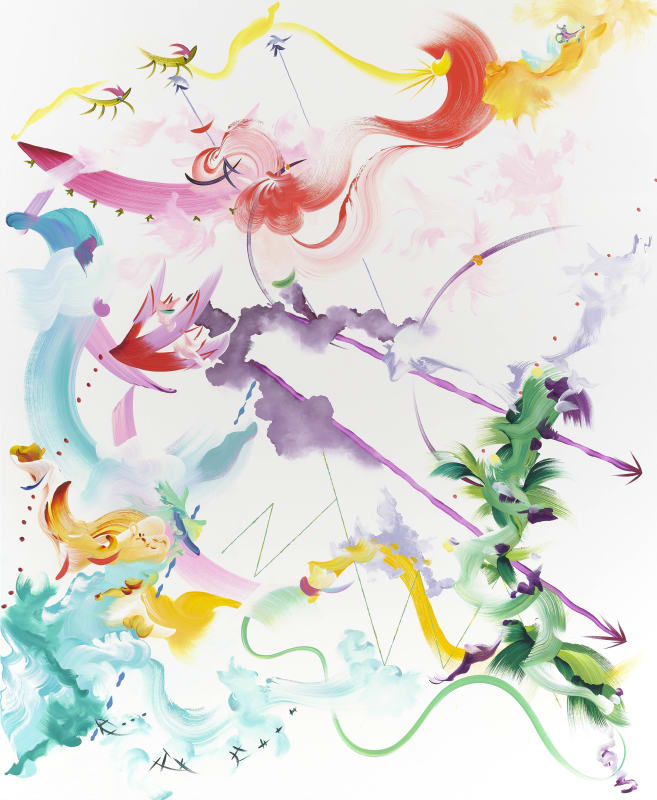Celebrating twenty-five years of collaboration, Galerie Nathalie Obadia is very pleased to present the sixth exhibition by British artist Fiona Rae, recognized as being one of the most important painters of her generation.
Born in Hong Kong, in 1963, and a graduate of Goldsmiths College, London, alongside Damien Hirst, Gary Hume, and Sarah Lucas, Fiona Rae first became known for her part in the Young British Artists group, to which we largely owe the renewal of the British art scene in the 1980s and 1990s. Since then, she has developed an abstract painting characterized by its phantasmagorical aspect, which attests to diverse and original influences, in "an iconoclastic approach to subject matter and formal concerns" (Fiona Rae).
On the occasion of this exhibition, the artist shows a new collection of canvas paintings and more intimate works on paper, her Abstracts, in line with her recent formal research. Her preliminary work in gouache and watercolour, less well known and more rarely exhibited, constitutes a set of ideas from which she creates her paintings and thus allows us to catch sight of their deve- lopment. The artist has chosen to present these two practices in a fixing that takes into account their mutual contributions and correspondences.
Fiona Rae's work incarnates an abstract-pop universe, filled with references to modern and contemporary painting, to pop culture, and to digital technology. Biomorphic forms float at the paintings' surface and bring to mind the surrealist visions of artists like Yves Tanguy, side by side with figurative elements borrowed directly from manga, comics, Walt Disney, Dr Seuss-quirky and playful resurgences that recall the work of Philip Guston and Takashi Murakami. The gestural, although organized treatment inscribes it in a form of painterly abstraction, while certain pictorial effects simulate the possibilities offered by Photoshop, revealing a painting practice that is resolutely anchored in her time.
The set of works presented is in a certain continuity with the series of Figures, which she began in 2014 in a grayscale palette. In 2017, the artist departed from these grays, completely eliminating black and its derivatives, in favor of pastel colors that tended toward artificial, magical hues. Her work on chromatic gradation became the backdrop for a theatrical choreography of shapes, pictorial gestures, and graphic signs, that were on the edge of the figurative world. All of Fiona Rae's pictorial efforts reside precisely in this subtle paradox: the abstraction must bring forth-then conceal-a universe of possible imagery, of familiar figures. The resulting works were ethereal, graceful landscapes, with arabesques, brushstrokes, arrows, vaporous and chimeric movements, that played the role of actors in a specific game, that of the painting.
However, the Abstracts series clearly indicates her position: Fiona Rae claims the influence of abstract pioneers such as Kandinsky, which she subtly combines with Pop Art, and these recent works seem to evolve towards a more prominent dynamism, more acidulous colours, and accentuate the contrast between curves, undulations and tense lines, spontaneity of gesture and reflected «mapping» of the painting.
Defending a notion of painting as a " romantic, magical thing " that " still has a place and a fascination, especially since the proliferation of technological possibilities ", Fiona Rae reflects on our contemporary visual culture, on our common experience whose data, signs, emblems, writings, impressions, and atmospheres she highlights. An "atlas," to borrow the term posited by Nicolas Bourriaud to describe Rae's paintings, in line with the great tradition of American abstraction and pop culture. The visual liberty displayed by the artist from the very beginning, founded on a certain "postmodern" mistrust for painting, was thus able to prevail as the singular, pertinent, and complex expression of a confrontation between many different worlds-a reflection of today's society.
I have titled this exhibition ABSTRACTS because I want to clarify the situation.
There is no intention to conjure up the figure, nor to suggest the landscape, let alone the still-life.
Each painting presents a set of brushmarks and each brushmark presents itself to the best of its ability. If there are references and associations beyond the actual presence of each mark, then that is the inevitable leaking, and delight, of our language systems; the impossibility of a hermetically sealed code.
I began by making a group of gouache and watercolour works on paper which I then used as sets of instructions for making the large paintings. There was ample opportunity for improvisation and invention, but by following an abstract composition which already existed on paper, I was able to recognise the painting as soon as it had appeared. An abstract painting can only ever look like itself and is paradoxically only successful once it looks like itself. Without a plan, the act of painting can turn into the nightmare of an en- dless search for the thing itself, the thing without a face.
I consider these paintings to be the contemporary descendants of the modernist pioneers of abstraction, such as Kandinsky, via the god-parenting of Pop Art, rather than Expressionism. The paintings are hyper abstract; the spiritual theories of utopian modernism take on the distancing strategies and meaningful referents of Pop, while returning the viewer always to the actual paint on the actual canvas. One dictionary definition of 'Abstract' is a 'description so vivid or graphic as to suggest a mental image or give an accurate idea of something'. I would add that an Abstract painting also simultaneously pulls the viewer away from the contemplation of vivid mental images because it insists upon its immediate presence in the world.
There are inevitably subtle acknowledgements of the post analogue space. The ground might slip and slide in a manner familiar to Photoshop users, but the paintings are themselves an argument for the continuing possibilities and relevance of painting in our digital screen-based age.
Fiona Rae, December 2019

